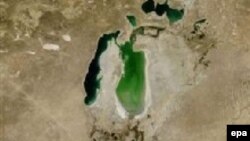After some four decades of depletion, the sea is showing signs of life. Experts say the northern part of the sea has returned to 40 percent of its original size.
Now, the Kazakh government has requested a new loan from the World Bank to begin the second phase of the effort to regenerate the sea.
The World Bank team leader for the Aral Sea Project, Joop Stoutjesdijk, says the bank is considering the feasibility of releasing more funds.
Decades Of Decline
The Aral, located between Kazakhstan to the north and Uzbekistan to the south, had shrunk to nearly a quarter of its original size over the past four decades. Stoutjesdijk, who is currently visiting Central Asia to assess the situation, says big changes can be seen today.
"If you go the sea tomorrow and talk to the fishermen, they will tell you a completely different story from two-three years ago, when there was little water, when there were drought conditions, when there were health issues," Stoutjesdijk says.
The Aral Sea was once the fourth-largest body of inland water in the world. During the 1960s, Sovietcentral planners diverted two main rivers feeding the sea -- the Amu-darya and the Sir-darya -- to irrigate cotton fields. As a result, Uzbekistan became one of the largest cotton producers in the world.
But agricultural success came at a heavy cost -- the sea began to shrink, the local fishing industry completely collapsed, and the region's climate began to change. The air became saturated with chemical dust and salt left behind as the increasingly polluted sea retreated, contributing to the misery of the local population. Ailments -- such as cancer, anemia, and allergies -- became widespread, causing average life expectancy to plummet from 64 years to 51.
The Aral disaster has been described as the worst man-made environmental catastrophe of the 20th century.
Water levels fell to the point that the sea split into two separate bodies of water -- the Northern Aral and the Southern Aral.
Over the past 15 years, regional and environmental efforts have been implemented to save the rapidly-depleting sea. Hundreds of millions of dollars have been spent. Each Central Asian country provides 1 percent of its annual budget for the restoration of the sea. The World Bank and the Asian Development Bank are among the major sponsors.
As a part of the regeneration project, a 13-kilometer dam was constructed in the North Aral to raise water levels and expand the sea's coverage area. Countries in the region are encouraged to improve their management of water to maintain water flow to the Aral.
Kazakh government and World Bank officials say that the Northern Aral, which is in Kazakhstan, stands a good chance of revival. Elena Karaban is the external-affairs officer of the World Bank's Central Asian Regional Office in Almaty.
"The water is now much closer to the port of Aralsk in the North Aral Sea," Karaban says. "It used to be 100 kilometers away. Now, if I am not mistaken, it is 15 or 20 kilometers away. So, the sea is coming back."
Low Expectations
However, even by the most optimistic estimates, the complete recovery of the sea is highly unlikely. The larger Southern Aral, which is located in Uzbekistan, has largely been left to diminish further as initial recovery efforts focus on the north.
Although the split sea borders Uzbekistan and Kazakhstan, all five Central Asian states have a role to play if the regeneration project is to succeed.
Most of the region's water resources are located in Tajikistan and Kyrgyzstan. Rivers that originate from the two countries irrigate lands in Uzbekistan, Turkmenistan, and Kazakhstan before flowing into the Aral Sea. Because of this, according to experts, water management and regional cooperation are of vital importance to the project.
The Central Asian states, however, do not easily find a common language when it comes to sharing natural recourses.
Uzbekistan, for instance, has had longstanding disagreements with neighbors over its provision of natural-gas supplies. Water resources have also been a source of dispute between Uzbekistan and Tajikistan.
However, Aral Sea Project leader Stoutjesdijk says the five countries have come to realize that the sea's demise is something that affects them all:
"It is true that we are not there yet -- there is no full agreement of how to share the water," Stoutjesdijk says. "But there is progress, there are talks, and there is a typically political will to reach an agreement on that."
Money Down The Drain?
But not everyone shares everyone shares the World Bank specialist's optimism.
Mels Eleusizov is the head of Nature, an environmental group in Kazakhstan. He tells RFE/RL that there is little to show for the vast amounts of financial and intellectual resources that have been poured into Aral recovery efforts.
"Usually, the money is provided, but it disappears," Eleusizov says. "There have been talks for so many years, but there is no concrete action. All those conferences, summits are just nonsense. Lots of money has been allocated, but there are no results."
In the meantime, those whose livelihoods once depended on the once busy harbors of the Aral can only hope that life will once again return to their "long-suffering" sea.
The Post-Soviet Environment
THE FRAGILE PLANET: Since the collapse of the Soviet Union, old environmental disasters have come to light and new ones have emerged. War, poverty, and weak central-government control have led to serious environmental problems from Eastern Europe to the Russian Far East. RFE/RL has provided extensive coverage of these important issues and of efforts to cope with them.
RELATED ARTICLES
Saiga Antelope's Saga Attracts New Allies
Project To Reverse Aral Sea Damage Making Progress
Iraqi Marshes Show Signs Of Strong Recovery
Deforestation Rampant In South And Central Asia
Environmentalist Says BTC Pipeline Could Be 'Death Of Caspian'
Scientists Raise Alarm As Man-Made Deserts Spread
Nature Waits For Cross-Border Sanctuaries To Catch On
Central Asian Vllagers Encouraged To Protect Snow Leopards
Environmentalists Raise Concerns About Russian Ecology Policy
